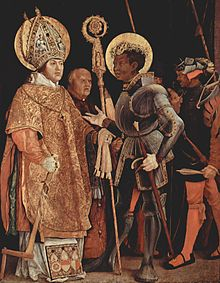St Maurice and Companions

The patron of soldiers, the Swiss Guards, weavers and dyers. Maurice was a black soldier in the 2nd century Roman army. In around 287AD, he served under General Maximian Herculius, in a legion that had been recruited entirely from Christians in Upper Egypt.
They were sent to Gaul to put down a revolt by Bagaudae tribe. When the army reached the River Rhone, the General ordered every soldier to make a sacrifice to the pagan gods, before the battle. The Legion refused to a man. When Maximian ordered them to harass some local Christians, they also refused. Maurice was their primicerius, or principal officer. In a form of Christian mutiny the men withdrew from the army and set up camp at Agaunum, now called Saint Maurice-en-Valaise.
When Maximian could not persuade them to make sacrifices to the gods, he ordered them to be killed. At first he had every tenth man executed. Then the entire legion was put to death. "We have seen our comrades killed," they said. "Rather than sorrow we rejoice in the honour done to them."
Writing in the 5th century, Eucherius of Lyons, says more than 6,600 men died in the massacre. Other historians say a great number of men lost their lives. The place in Switzerland where this occurred, known as Agaunum, is now named Saint Maurice-en-Valais, site of the Abbey of Saint Maurice-en-Valais.
St Maurice became very popular throughout Europe and is patron of many places, including Piedmont, Savoy and Sardinia. In art he is usually depicted as a tall black foot soldier. Eight ancient English churches are dedicated to him.












